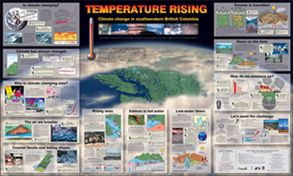Proactive disclosure
Print version   |  | 
Natural Resources Canada > Earth Sciences Sector > Priorities > Climate Change Impacts and Adaptation > Curriculum Tools
Climate Change in Canada - Curriculum Tools
Grade 5 - Teacher's Resource Temperature Rising: Climate Change in Southwestern British Columbia
Please note: These exercises are not designed to be filled out nor printed from your Web browser. Please download and print the PDF files located at the bottom of the page.
The Causes of Climate Change
Did You Know?
- How much water does each person use at home every day?
Over 300 L
- What is the source of nearly 30% of the greenhouse gas emissions in the lower Fraser Valley?
Motor vehicle exhaust
- What animals are shown as methane producers?
sheep and cattle
Why is Climate Changing Now?
- What turning point saw additions of CO2 to the atmosphere overtake removals?
Industrial Revolution
- What are the causes of the rapid build-up of CO2 in our atmosphere?
Human activities: burning fossil fuels, deforestation, agricultural practices
How Do We Measure Up?
- Out of individual household CO2 emissions, what % does automobile use put out?
45%
- What activities contribute to 75% of CO2 emissions that are not individually produced?
Transportation, electricity generation, fossil fuel production, agriculture, community and industrial waste, other industry
| Connections |
Reflections |
Questions |
| What connections can you make among what you've learned, your lifestyle, your family, school, community, or other regions? |
Reflect on your learning, understandings, and discoveries."Write about one thing you did not know before starting this activity" |
What questions do you still have, or what new questions have been raised? |
The Consequences of Climate Change
Is Climate Changing?
- How do glaciers behave when climate changes?
Expand when cools/shrink when warms
- By how much is the global temperature expected to rise above 1980 levels by the year 2100?
~ 4.5 - 5║C
- Where does the global map indicate the most significant temperature changes will occur?
The poles
The Air We Breathe:
- What gets trapped in the Fraser Valley?
Smog
- What will happen to the number of "bad air" days as climate warms?
Increase
Coastal Floods and Failing Ships
- What are the predictions for future winters in coastal British Columbia?
Wetter and stormier, more floods
- Are slopes more or less at risk with wetter winters? Explain.
More at risk, due to the reduced stability of the slopes
Rising Seas:
- As climate warms, what will happen to glaciers?
Melt = increased seawater
- What areas are most vulnerable to rising sea levels?
Deltas, tidal marshes, low-lying coastal areas
- What is the "coastal squeeze"?
Loss of coastal land, and "squeeze" on developed cities and their dykes
Salmon in Hot Water:
- Why might tuna and mackerel replace salmon stocks in southern B.C.?
They live in warmer waters, while salmon are a cooler water fish.
- How might salmon be affected with warmer waters?
Use up energy stores, unable to reach spawning grounds, increase risk of fungal and bacterial infections
Low-Water Blues:
- What industry will largely be affected by changes in river flow with climate warming?
Hydroelectric power generation
Forests in Transition:
- What impact will climate warming have on the B.C. forest industry and economy?
Improved growth and yield; Loss due to increased fire
Down on the Farm
- What impacts of warming will have "mixed blessings" for the interior of B.C.?
Better growing conditions vs. increased drought
- How will climate warming influence pest impacts on crops?
It will increase the impact pests have.
| Connections |
Reflections |
Questions |
| What connections can you make among what you've learned, your lifestyle, your family, school, community, or other regions? |
Reflect on your learning, understandings, and discoveries."Write about one thing you did not know before starting this activity" |
What questions do you still have, or what new questions have been raised? |
Action on Climate Change
Let's Meet the Challenge
- What ideas will help reduce greenhouse gas emissions?
Lifestyle choices, government policies, new technologies, alternative energy sources
| What I am already doing... |
What I can begin to do... |
|
|
Downloads:
|

